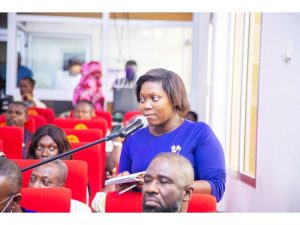
In order to protect lives and properties that are usually lost through perennial flooding in the country’s capital, government has developed the Flood Early Warning System (FEWS).
This was announced by the Minister for Works and Housing, Mr Francis Asenso-Boakye, at a press conference organised by the Ministry of Information in Accra yesterday.
The FEWS, which will be in operation by the end of next year, will ensure that advance notices are given to flood-prone communities, towns and cities to enable them take precautions.
“…Moreover, the design of a Flood Early Warning System for Accra has been completed …People in vulnerable communities will have the benefit of advance notice of floods, so they can take steps to protect lives,” Minister Asenso-Boakye said.

The System has been designed to operate in a Pull and Push format. The Pull system will require individuals to download an application onto their mobile phones and get access to issues concerning floods, while the push system will involve the central operators sending key messages to individuals.
The Minister noted that the system is part of the Greater Accra Resilient and Integrated Development (GARID) Project, which is intended to improve flood risk management and solid waste management in the Odaw River Basin of the Greater Accra Region and improve access to basic infrastructure and services in the targeted communities within the Odaw River Basin.
He again noted that it is part of the many other interventions the government is putting in place to salvage flood issues in the capital and beyond.
He took time to outline some other initiatives the government is working on to curb floods in the capital and other flood prone areas in the country.

According to him, a total of 35km of drains were constructed as a result of the 2018 and 2020 National Flood Control project and mentioned some of the beneficiary communities as; Madina Mayehot and Weija GICCEL in the Greater Accra region.
Kasoa Iron City and Kosoa Obom City are some of the places in the Central region that benefited from the project, while the people of Kwesimitsim were the ones that benefited from a drainage project in the Western region.
The Bantama Legislator also noted that climate change is one of the factors that causes floods and in order to mitigate them, the government has ensured that drainage infrastructures that are being put up in the country are flood-resilient.
Minister Asenso-Boakye also observed that the habit of building on waterways and the dumping of refuse in gutters are other contributing factors to floods.
He noted that to solve this issue, Metropolitan, Municipal and District Chief Executives (MMDCEs) have been tasked to ensure that obstructions to the free flow of water, as well as developments along water ways are removed immediately.
“MMDAs must strictly enforce the planning laws and punish officials who flout the planning laws in our bid to protect lives and livelihood”.
Aside floods, Mr Asenso-Boakye also noted that coastal erosion has been a headache to some coastal communities in the country and hence took time to touch on some projects that the government has put in place to savage the situation.
“Over the years, coastal areas have remained vulnerable to coastal erosion and this risk is exacerbated by the potential rise in sea level.
“Accordingly, government has considered the protection of the country’s coastline as very critical to our development. Government has implemented several coastal protection projects to safeguard the lives and livelihoods of people living in coastal communities.”
He made mention of the Komenda, New Takoradi, Aboadze, Cape Coast, Anomabu, Ningo Prampram coastal protection projects, which are at various stages of completion, and assured that government will complete them in order to protect the lives of people living in coastal areas.








